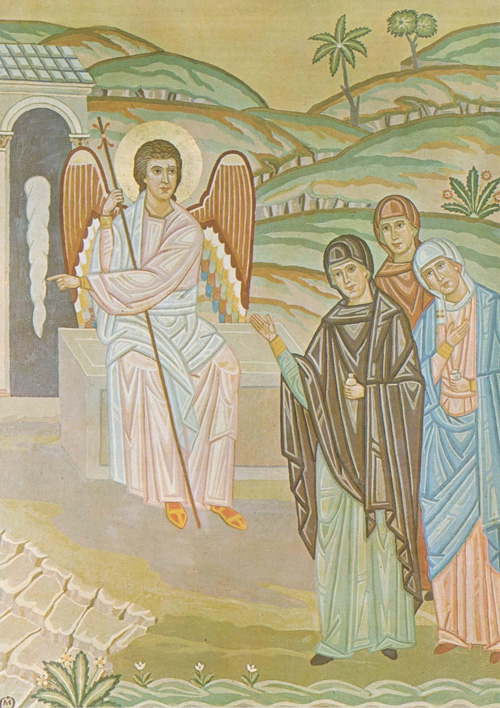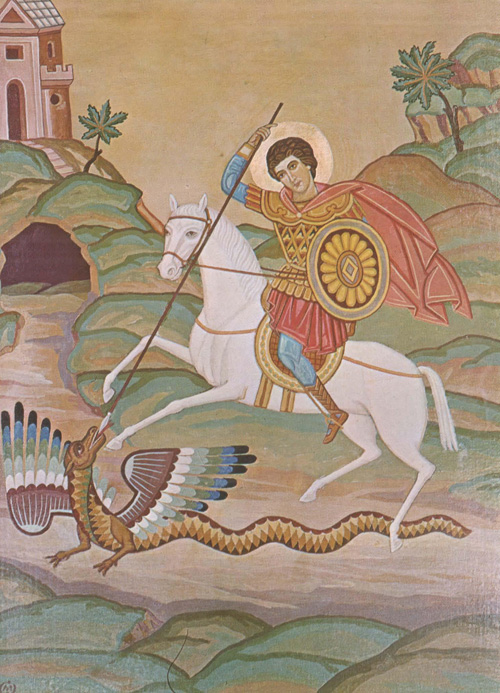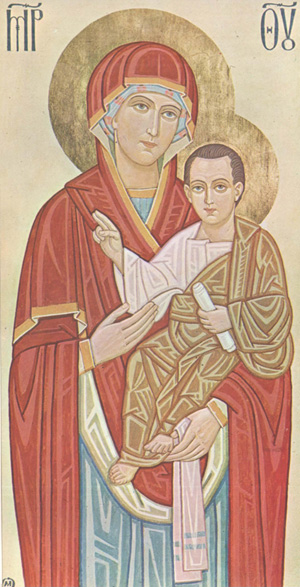In the autumn of 1910 I was admitted to the Academy of Fine Arts in Cracow, Poland. I entered the studio of Professor Joseph Pankiewiez, who was considered to be an exponent of the modern trend (French Impressionism at that time). At the same time I enrolled in the Department of Philosophy of Jagiello University for courses in art history and aesthetics, intending after the completion of my studies to be active, with brush as well as word, in the field of Ukrainian art.
Instruction in the class of Professor Pankiewiez adhered strictly to the prevalent academic system, in that he stressed the assiduous observation of the model, correct drawing, and, in painting, suitable contrasting of colors. Usually I spent the morning and the evening hours at the Academy, and attended lectures at the University in the afternoon. From time to time I participated in seminars under the guidance of Professor Mycielski, where the students discussed various art topics. It was here that I first learned that in the fourteenth and the fifteenth centuries Ukrainian icon painters had been commissioned by the Poles to paint murals in the churches of Poland. One of these works was in the Swietokrzyska Chapel of the Wawel Cathedral of Polish Kings in Cracow. However, these frescoes were no longer in their original state, because at the end of the nineteenth century they had been skillfully restored by an overpainting with tempera to preserve the original drawing, imitating faded colors of the composition.
When in the next academic year my friend Mykola Fediuk was admitted to the Academy, our common interest in those frescoes and icon painting become increasingly dynamic. We started to copy the frescoes and to study their style. In numerous discussions, we came to the conclusion that the elements of icon painting are of utmost importance to Ukrainian art. The style of the icon persisted in our churches for seven full centuries, and was slowly displaced in the seventeenth century, when the baroque introduced westernized religious painting. It became evident to us that if Ukrainian art was to have characteristic traits of its own, the iconographic tradition had to be respected — namely, the further progress of Ukrainian art must be based on the art of icon painting. After finishing our studies at the Academy, we hoped to effect a change in Ukrainian church decoration. This change was to be introduced first in the village church, as the place where the prevailing part of our nation — the farmers — could come in touch with the art.
The First World War disrupted our plans — instead of painting we had to fight. At the end of August, 1921 I returned from the Ukrainian Liberation War to my home town, which in the meantime had become a part of new Poland. After two months of waiting I had to accept a position as teacher in Drohobych in order to avoid confinement to a Polish POW camp in Tuchola. In September of 1922 I transferred to a new position at the main Ukrainian high school in Lviv, the center of cultural life in Western Ukraine under Polish occupation. Here I made the acquaintance of Mr. Peschansky, restorer of old icons for the National Museum, and with his help acquired a good knowledge of icon painting technique. Together with Mykola Fediuk and Yaroslava Muzyka, I set out to create an art in the traditional iconographic style. My first work in this field was the icon of the Sacred Heart for the Church of the Transfiguration in Lviv in 1923.

Michael Osinchuk – Resurrection. 1963.
My teaching occupation left me but little time for artistic creativity, so in 1926 I abandoned teaching in order to devote my full time to the new decorative work, as I had originally decided years ago at the Academy. My first larger work in the iconographic style was the multicolored decoration (polychromia) of the church in Hrymaliv (Skalat region of Western Ukraine) in 1927. In my second work I collaborated with the artist Pavlo Kovzhun in Sokal: he did the ornamental and I the figurative part of this polychromia. We had several village youths as assistants, and they later became independent painters of decorative church art. At first our polychromia was somewhat overloaded with details, since the late artist Pavlo Kovzhun was prone to rich ornamentation. In later works the relation between the ornamental and the figurative parts was better balanced—the icons together with the ornaments achieved a harmonious arrangement full of expression.
Up to this time, the traditional decoration of churches was in a sorry state. The typical polychromia of the time was realistic and of poor quality. The decorative work done by M. Sosenko and J. Bucmaniuk in their specific style was of high caliber, but the remainder of church decorative work was run-of-the-mill compilation. The ornaments consisted of stencilled embroidery, and the figurative paintings were usually copies of conventional religious pictures such as those sold at the county fairs. The farmers accepted this decoration, having nothing else to choose from. However, the fact that the iconographic polychromia had survived in Ukraine until the seventeenth century indicated that this art form had quality which appealed to the psyche of the farmer. For this reason, polychromia became for me the source of inspiration in my works of church art.
The icon came to Ukraine, together with Christianity, many years before the principality of Rus’ (medieval Ukraine) converted to Christianity during the reign of Volodymyr the Great. The icons were brought in by the chumak-merchants, whose ox-cart caravans visited Greece every year with their loads of grain, wax and furs from Ukraine. The center of this trade was in the Macedonian Ochrida lake region, and the first icons came to our country from this area. The Macedonians had once conquered Asia under the leadership of Alexander the Great, and had spread Hellenistic culture there. Byzantium, as the capital of the Eastern Roman Empire, took over this heritage and gave its name to the new art form which arose on this territory. Byzantine art evolved in the agricultural areas of Asia Minor through fusion of Hellenistic tradition with Asian symbolism. Not only the Ukrainian people, but the other Christian neighbors of Byzantium as well, adopted this art and developed it according to their national characteristics and psyche. Thus arose the Greek, the Bulgarian, the Serbian, the Ukrainian, the Byelorussian, and the Russian iconography, with differences clearly apparent to anyone familiar with the distinct national characteristics of these peoples.
In the western part of Ukraine, which up to the fourteenth century was the realm of the Kingdom of Galicia and Volhynia, iconography reached a very high level of artistic quality, due to the region’s close cultural and trade links with Byzantium. Under the Rostyslavychi dynasty, the Galician army was entrenched in the stronghold of Halych on the mouth of the Danube (at present Rumanian Galatz), checking trade along the river. The Galician prince Yaroslav, together with the sons of boyar lords, resided at the court of the Byzantine emperor Maximos, whose wife was his aunt. The young men were educated here, in the center of the European culture. Later, when Yaroslav became the ruler of the Galician kingdom, he was praised for his wise reign by the chronicles of the time, and given the surname “Osmomysl”, meaning a man with eight senses. The Ukrainian epic of the twelfth century, “The Tale of Prince Ihor’s Campaign”, also praises Yaroslav as the most powerful ruler of the time. Under the Romanovychi dynasty, the Galician kingdom maintained close links with Byzantium until the middle of the fifteenth century. When after the fall of Constantinople the Turks extended their domination along the coast of the Black Sea, Ukrainians not only lost access to the Danube, but also found themselves driven step by step from their possessions on the Dnister by Armenian tradesmen supported by the Turks.

Michael Osinchuk – St. George. 1954.
The icon painting corresponded to the psyche of the Ukrainian farmer in its rhythmical composition and symbolic meaning. The peasant’s daily work was in a sense rhythmical: the tilling of a field (long rows of harvested wheat) ; the gathering of the ripe grain during the harvest, when rows of sheaves were piled up behind the reapers and the reaped strips of field lay behind the moving scythes; the carting of grain, with one cart after another, loaded with the sheaves, heading towards the village; the sheaves themselves finally stacked in the yard of every farmer. The symbolic conception of the world, on the other hand, arose in the farmer’s mind, since he relied in everything on good weather, which to him was a supernatural force — the only force that could insure his success. Even the most diligent labor would have been useless without God’s help. In the pagan era, this force was Dazhboh (a mythological deity), and in the Christian era the Almighty took his place. If God did not help, drought could reduce the crops to nonexistence, or the finest grain could be ruined by hail. The symbolic supernatural force had to prevent such happenings, and the farmer relied on it fervently. The icon helped the farmer’s imagination to envisage this force, and therefore the icon was to him both powerful and intimate.
The historic icon could not survive repeated invasions and ruin in Ukraine. The southern territories were regularly invaded by Tartars, but when the Ukrainian lands fell under Russian domination, the remainder of those icons which were left after the Tartar raids was pillaged by Moscow. Today these icons repose in the Russian museums, described by art historians as a Russian heritage. Only in the Western Ukraine, which was under Austrian occupation, were the historical icons preserved. The wooden churches in the villages had the best climatic conditions for the preservation of such paintings, and the farmers also cherished and valued them immensely, defending them against any destruction. The West Ukrainian icon, in addition to its general stylistic characteristics, had special features stemming from the surroundings in which it was created. The southern regions of Western Ukraine (Sambir area) had distinguishing features quite different from the northern icons of the Rava Ruska area. The southern icon was more graphical, whereas the northern icon had rather a plane-colored character. Two great metropolitans of the Ukrainian Catholic Church, the late Andrew Sheptytsky and the present, Cardinal Joseph Slipy, saved the remainder of the West Ukrainian iconographic heritage by creating special museums in Lviv: the National Museum and the Museum of the Theological Academy.
Certain changes were necessary for my re-introduction of iconography into the church. It was impossible to just transfer the copy of a historical icon into an era of different people and conditions. I had to take only the basic features of the old icon: the linear, the rhythmical color movements, and the symbolic meaning in the composition itself. The faces in my painting, however, had a more naturalistic expression, and had lost some of their schematic severity. On the other hand, the linear rhythmical movement was more pronounced in my icons. Instead of the local colors of the icon, I introduced the correlative tones according to modern color concepts. The modeling of draperies was produced not by the so-called “probily”, i. e., by the highlights which were carried out in white lead, but by each color plane of drapery taking the form of three tonal shades. The color arrangement of the ornamental adornment was produced in the same way. Therefore, this new polychromia of the church, equally treated in the ornamental and pictorial parts, had the prevailing effect of a harmony of colors and values, and thus evoked an exalted mood — which, together with the singing, makes our liturgies so enchanting. This multicolored mural decoration and the liturgical singing are, so to speak, part of our national identification.

Michael Osinchuk – Mother of God. 1954.
To the question of why I refer to the icon of the past for inspiration, when every artist nowadays is striving to create something that has not yet been done and is rasping the psyche of the spectator by delirious compiling of pictorial elements and dissonant tones, I have a simple answer. I am a villager, a child of the soil, and have inherited a relationship with the soil from rny forefathers. For them the soil was like a member of the family, another mother, since it was the source of the sacred daily bread. The farmer regarded it with reverence and love. How he rejoiced in the early spring when, on examining the winter crop culture, he saw that smooth green carpet in the field! How delighted he was amidst the sea of ripening grain in summer, watching the shadows of the fleecy clouds run across the waves of wheat! This was the sensuous poetry of the farmer. I remember the times when I used to go with my father to reap the barley in the early morning during my summer vacation. The piercing rustle of the rake, as it placed the grain into evenly reaped strips of field, created a feeling of tranquility which cannot be described. The wide horizon of the blue sky above an immense field of golden grain gave me a sensation of peace, which filled my heart to the brim.
The farmer experienced similar feelings in the church. Every Sunday and holiday he went there not only to hear the liturgy and to pray, but also to forget all his worries amidst the icons and their adornments. They and the devotional singing transported his mind into another world, a world of quietude, a world of dreams, bringing him relaxation and escape from the strenuous daily toil. The icons and the multicolored mural decoration surrounding him helped him, by their rhythmical calmness, to forget the trivialities of life.
Today, all this has disappeared from our homeland, the land of Ukraine. There is no trace of a proud farmer in the field, one who is unique king on his few acres of soil. The Russian Communist invasion has liquidated not only the large, but also the small landowner. In his place there is the kolkhoz servant. The villagers are leaving their rural life, trying to find work in the cities of the machine shops. The tempo of the machine is somehow too fast, too nervous for a farmer. The rhythm of work around the machine is not the rhythm of rural work. It is contrary to the farmer’s psychic predisposition for the calm, steady rhythm of work in the field, which he has inherited from his parents, and which cannot be eradicated from his heart. Communism has also changed the West Ukrainian village. As its fields have disappeared, so has its church been destroyed. Instead of God the villager must glorify the Party and the communist idols. If, by chance, my polychromia is still existent in some village, it may remind the villager of the old iconographical tradition, and will perhaps become the swan song of the old village. I think, however, that even in the kolkhoz barracks the love of iconography and the feeling for its rhythmical harmony will not vanish so soon.



